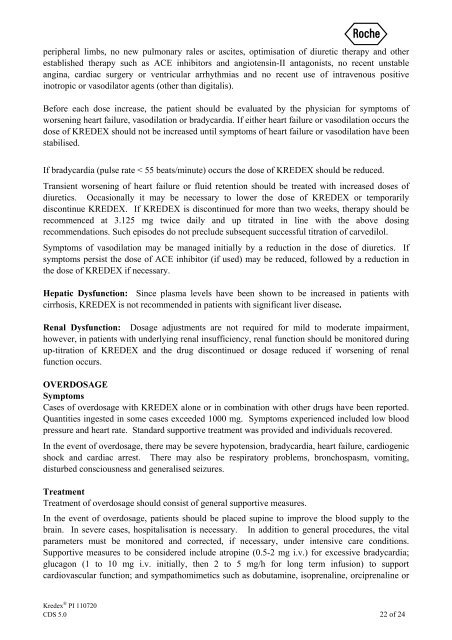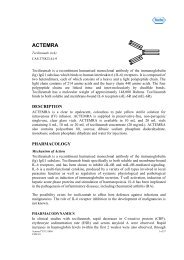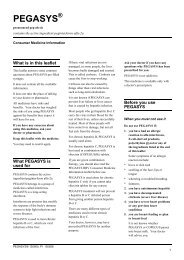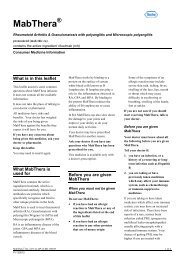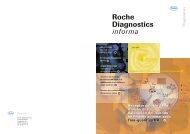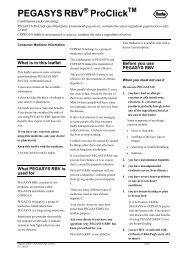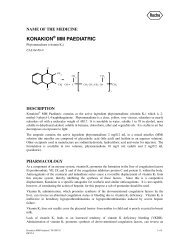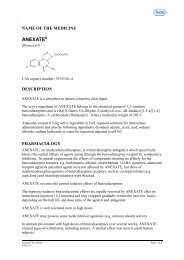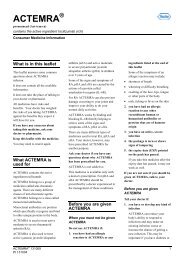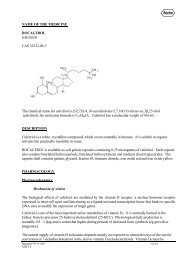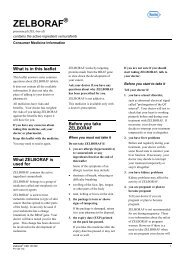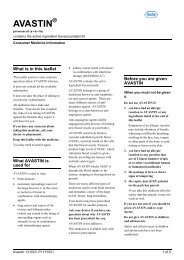Kredex (carvedilol) - Product Information (PI) - Roche Australia
Kredex (carvedilol) - Product Information (PI) - Roche Australia
Kredex (carvedilol) - Product Information (PI) - Roche Australia
You also want an ePaper? Increase the reach of your titles
YUMPU automatically turns print PDFs into web optimized ePapers that Google loves.
peripheral limbs, no new pulmonary rales or ascites, optimisation of diuretic therapy and other<br />
established therapy such as ACE inhibitors and angiotensin-II antagonists, no recent unstable<br />
angina, cardiac surgery or ventricular arrhythmias and no recent use of intravenous positive<br />
inotropic or vasodilator agents (other than digitalis).<br />
Before each dose increase, the patient should be evaluated by the physician for symptoms of<br />
worsening heart failure, vasodilation or bradycardia. If either heart failure or vasodilation occurs the<br />
dose of KREDEX should not be increased until symptoms of heart failure or vasodilation have been<br />
stabilised.<br />
If bradycardia (pulse rate < 55 beats/minute) occurs the dose of KREDEX should be reduced.<br />
Transient worsening of heart failure or fluid retention should be treated with increased doses of<br />
diuretics. Occasionally it may be necessary to lower the dose of KREDEX or temporarily<br />
discontinue KREDEX. If KREDEX is discontinued for more than two weeks, therapy should be<br />
recommenced at 3.125 mg twice daily and up titrated in line with the above dosing<br />
recommendations. Such episodes do not preclude subsequent successful titration of <strong>carvedilol</strong>.<br />
Symptoms of vasodilation may be managed initially by a reduction in the dose of diuretics. If<br />
symptoms persist the dose of ACE inhibitor (if used) may be reduced, followed by a reduction in<br />
the dose of KREDEX if necessary.<br />
Hepatic Dysfunction: Since plasma levels have been shown to be increased in patients with<br />
cirrhosis, KREDEX is not recommended in patients with significant liver disease.<br />
Renal Dysfunction: Dosage adjustments are not required for mild to moderate impairment,<br />
however, in patients with underlying renal insufficiency, renal function should be monitored during<br />
up-titration of KREDEX and the drug discontinued or dosage reduced if worsening of renal<br />
function occurs.<br />
OVERDOSAGE<br />
Symptoms<br />
Cases of overdosage with KREDEX alone or in combination with other drugs have been reported.<br />
Quantities ingested in some cases exceeded 1000 mg. Symptoms experienced included low blood<br />
pressure and heart rate. Standard supportive treatment was provided and individuals recovered.<br />
In the event of overdosage, there may be severe hypotension, bradycardia, heart failure, cardiogenic<br />
shock and cardiac arrest. There may also be respiratory problems, bronchospasm, vomiting,<br />
disturbed consciousness and generalised seizures.<br />
Treatment<br />
Treatment of overdosage should consist of general supportive measures.<br />
In the event of overdosage, patients should be placed supine to improve the blood supply to the<br />
brain. In severe cases, hospitalisation is necessary. In addition to general procedures, the vital<br />
parameters must be monitored and corrected, if necessary, under intensive care conditions.<br />
Supportive measures to be considered include atropine (0.5-2 mg i.v.) for excessive bradycardia;<br />
glucagon (1 to 10 mg i.v. initially, then 2 to 5 mg/h for long term infusion) to support<br />
cardiovascular function; and sympathomimetics such as dobutamine, isoprenaline, orciprenaline or<br />
<strong>Kredex</strong> ® <strong>PI</strong> 110720<br />
CDS 5.0 22 of 24


